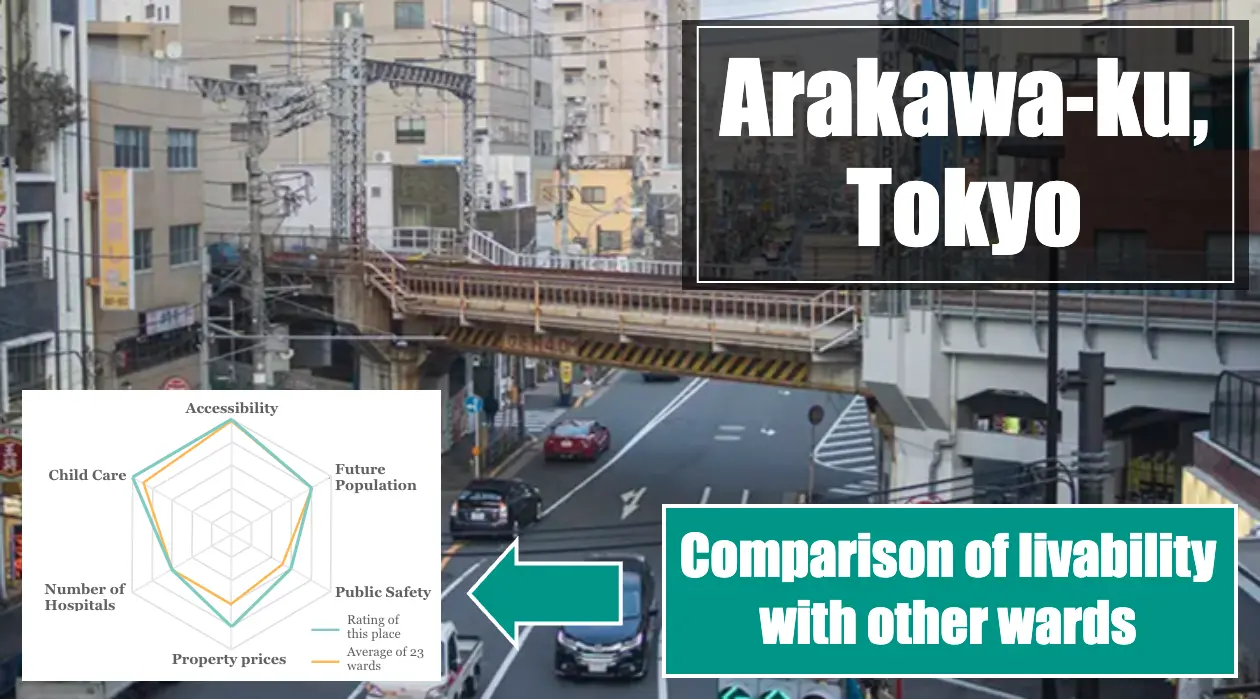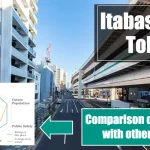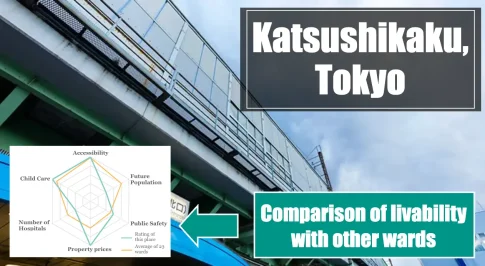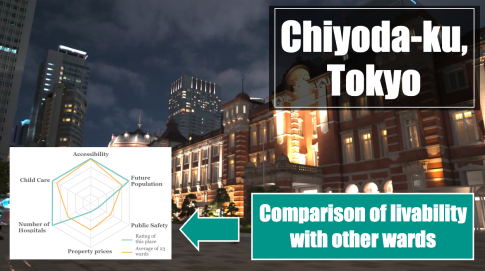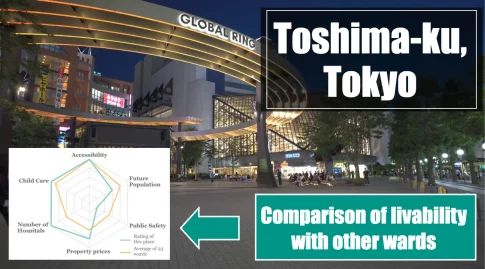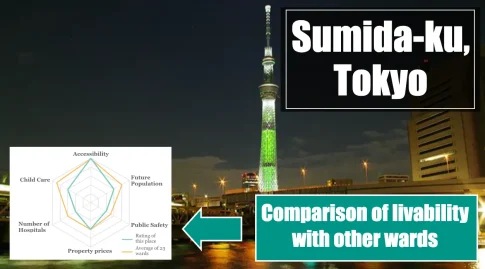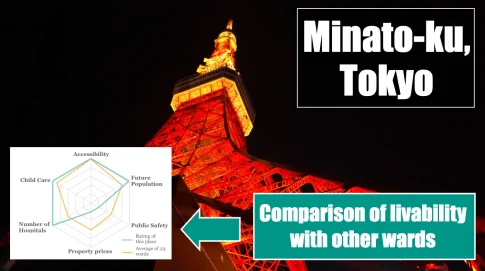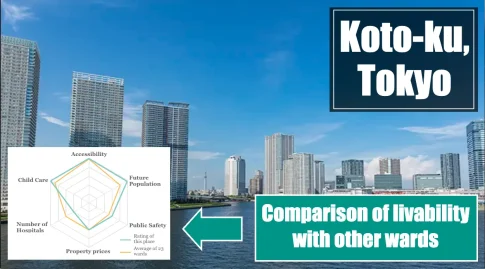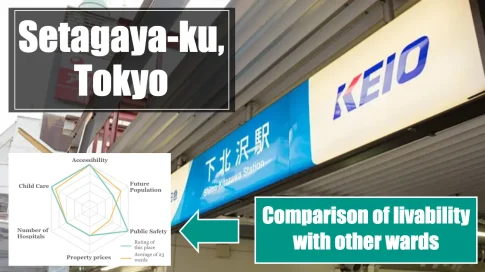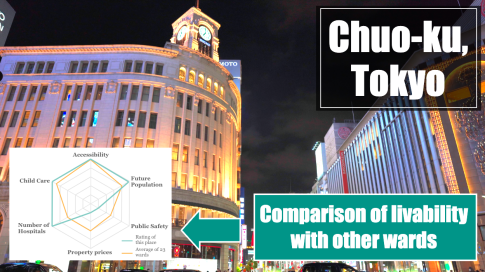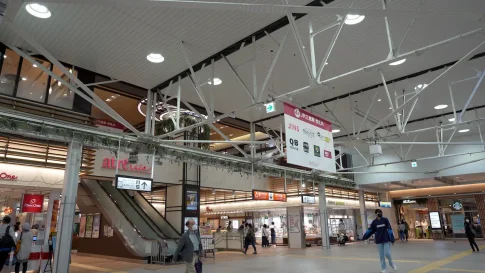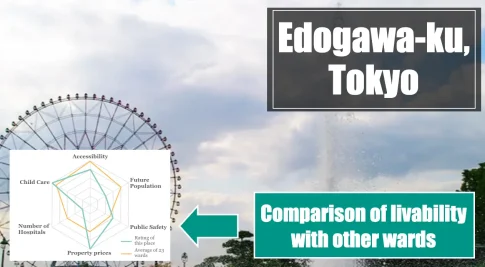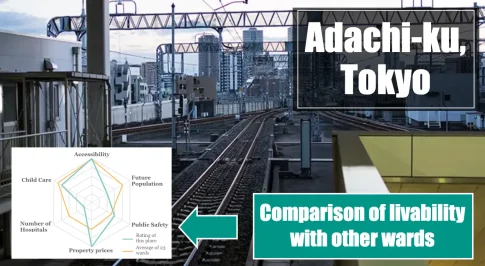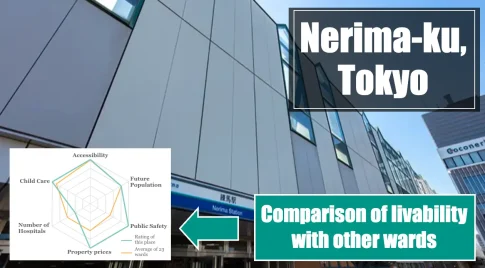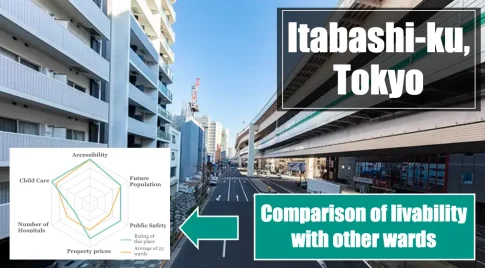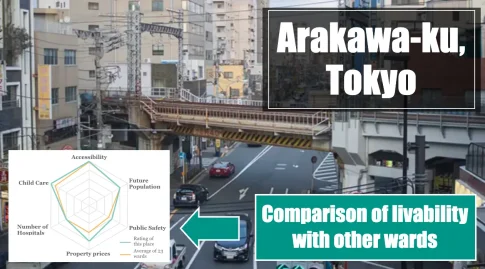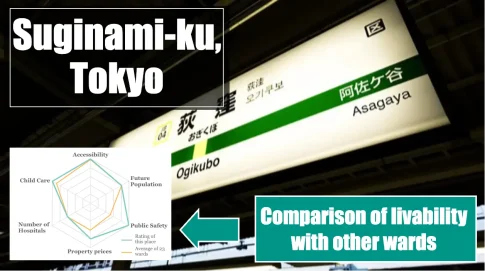What you can learn from this article: The livability of Arakawa Ward in Tokyo compared to other 23 wards
Contents
The livability of Arakawa Ward | Conclusion first
Pros
- Future population is expected to increase
- No waiting children for childcare
Cons
- Many narrow streets
- High density of housing
The livability of Arakawa Ward in Tokyo can be succinctly described as a city with an increasing future population and no waiting children for childcare. On the other hand, the bad point is that the disaster risk is high.
Below, we will introduce more details with specific numbers, so please read until the end.
Comparison of Arakawa Ward and other wards
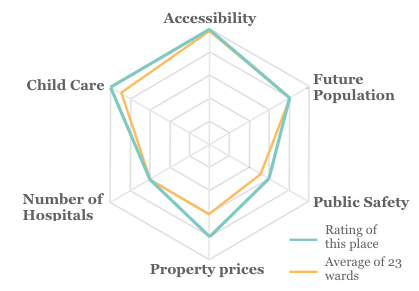
▼Accessibility
Calculated by the time it takes to get out to the Yamanote Line station.
5 = within 15 minutes
4 = within 20 minutes
3 = within 25 minutes
2 = within 30 minutes
1=more than 30 minutes
▼ Future Population
Calculated as percent change in population in 2045 relative to current population.
Over 110% = 5
Over 100% = 4
Over 90% = 3
Over 80% = 2
Less than 80% = 1
▼ Public Safety
The number of perceived crimes per 1,000 population is evaluated using the following criteria
5= less than 4 crimes per 1,000 people
4= less than 5
3= less than 6
2= less than 8
1= more than 8
▼ Property prices
Compared to the respective averages for rentals and condominiums in the 23 wards of Tokyo
5=30% or more reasonable price
4=10% or more but less than 30% of the price of the property
3=Less than 10% of the price before or after
2 = 10% or more but less than 30% more expensive price
1 = 30% or more expensive price
and then summed and re-evaluated.
▼ Number of medical facilities
(The number of medical facilities is evaluated against the average of Tokyo’s 23 wards (excluding extremely expensive wards) using the following criteria.
5=30% or more
4=10% or more but less than 30
3=10% or more, but less than 10%.
2=10% or more but less than 30
1=30% or more
▼ Child Care
The following criteria are used to evaluate against the number of children on waiting lists.
5 = 0 children on waiting list
4=Less than 5 children on the waiting list
3=Less than 10 children on the waiting list
2=Less than 50 children on the waiting list
1 = 50 or more children on the waiting list
The green line is the evaluation of Arakawa Ward, and the orange line is the average evaluation of other 23 wards in Tokyo. Let’s take a closer look at each one.
The accessibility of Arakawa Ward

The list of lines and stations in Arakawa Ward
- JR Yamanote Line: “Nishi-Nippori Station” and “Nippori Station”
- JR Keihin-Tohoku Line: “Nishi-Nippori Station” and “Nippori Station”
- JR Joban Line (Ueno-Sendai): “Nippori Station”, “Mikawashima Station”, and “Minami-Senju Station”
- Keisei Main Line: “Nippori Station”, “Shin-Mikawashima Station”, and “Machiya Station”
- Tokyo Metro Chiyoda Line: “Machiya Station” and “Nishi-Nippori Station”
- Tokyo Metro Hibiya Line: “Minami-Senju Station”
- Toden Arakawa Line: “Minowabashi Station”, “Arakawa-Itchumae Station”, “Arakawa-Kuyakushomae Station”, “Arakawa-Nichome Station”, “Arakawa-Nanachome Station”, “Machiya-Ekimae Station”, “Machiya-Nichome Station”, “Higashi-Ogu-Sanchome Station”, “Kumanomae Station”, “Miyano-Mae Station”, “Oji-Ekimae Station”, “Arakawa-Yuenchimae Station”, and “Arakawa-Shakomae Station”
- Toei Nippori-Toneri Liner: “Nippori Station”, “Nishi-Nippori Station”, “Akado-Shogakkomae Station”, and “Kumanomae Station”
- Tsukuba Express: “Minami-Senju Station”
Arakawa Ward has 9 lines and 24 stations.
Arakawa Ward is convenient for moving around Tokyo by JR lines and subways, and also for traveling to other prefectures by Keisei Main Line to Narita Airport, JR Joban Line to Miyagi Prefecture, Tsukuba Express to Ibaraki Prefecture, and JR Keihin-Tohoku Line to Saitama and Kanagawa Prefectures.
The population and future population of Arakawa Ward
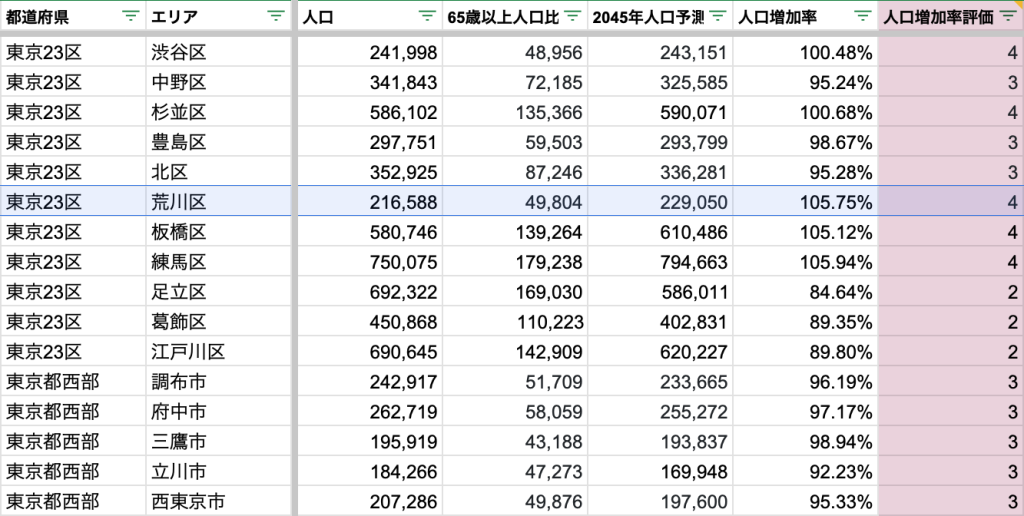
The population of Arakawa Ward is about 216,600.
The future population in 2045 is expected to increase to about 229,050 (105.75%) from the current level. While the population decline is predicted for the whole of Japan, Arakawa Ward is expected to increase.
Is Arakawa city safe?
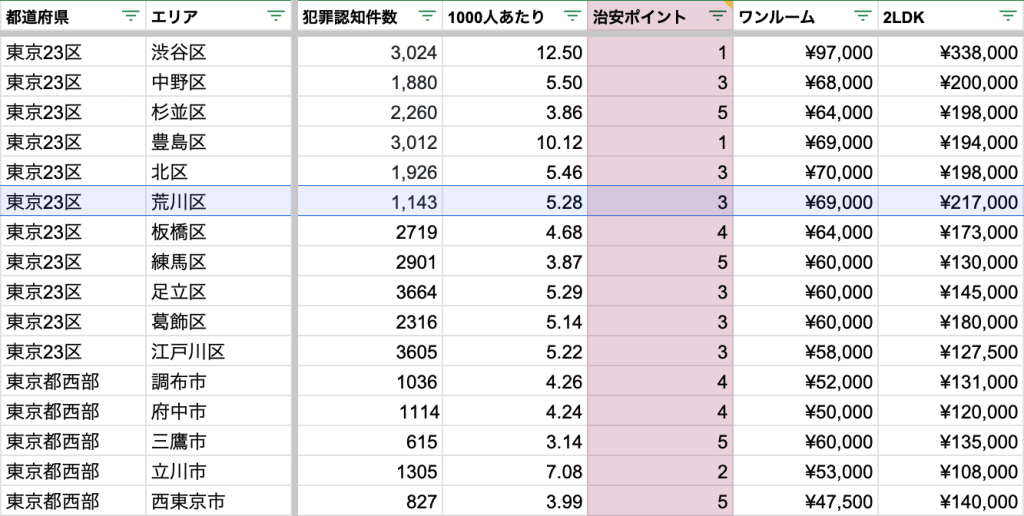
The security of Arakawa Ward is “average”.
The number of crimes in 2022 was 1,143. This is 5.28 cases per 1,000 people in Arakawa Ward.
The number of crimes per 1,000 people in other wards is about 6 to 7 on average. Compared to that, the security of Arakawa Ward is “average”.
The property prices of Arakawa Ward

- One-room rental = about 70,000 yen
- 2LDK rental = about 220,000 yen
- Condominium = about 50 million yen
- Detached house = about 60 million yen
The rental and condominium prices of Arakawa Ward are as follows.
Compared to the surrounding wards, the property prices of Arakawa Ward are slightly cheaper.
The number of hospitals in Arakawa Ward

Arakawa Ward has 197 medical facilities. The number of facilities per 1,000 people is 0.91. This number is average compared to other 23 wards in Tokyo.
The childcare of Arakawa Ward
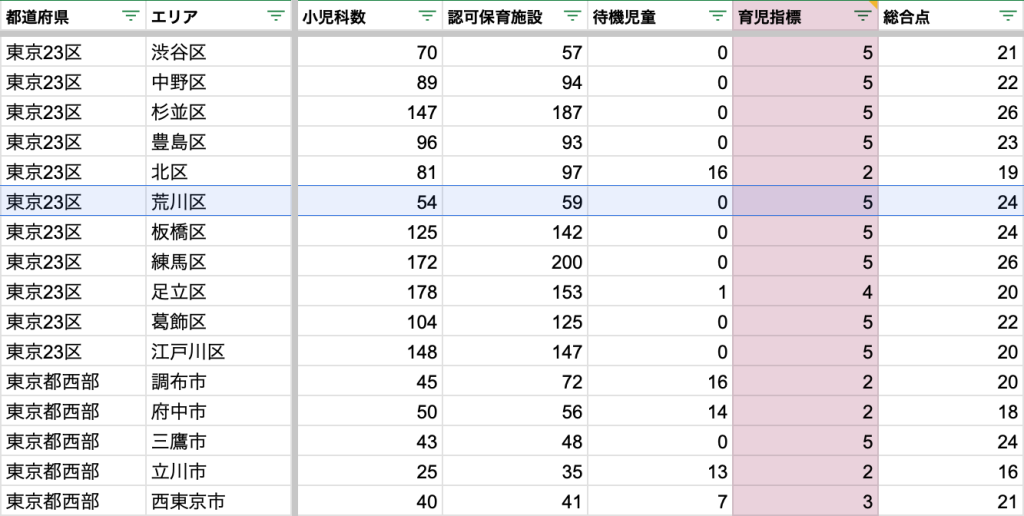
In 2022, the number of waiting children in Arakawa Ward was 0. Also, there are 54 pediatric clinics and 59 authorized childcare facilities.
There are wards in the 23 wards of Tokyo where waiting children occur. On the other hand, Arakawa Ward has 0. This is a nice point if you want to leave your child.
The earthquake risk of Arakawa Ward

The above is a diagram that color-coded the “overall risk” of five levels calculated from the two factors of “building collapse risk” and “fire risk”.
Arakawa Ward has from the lowest risk rank 1 (light blue area) to the highest risk rank 5 (brown area).
The areas with particularly high risk (rank 5) in Arakawa Ward are as follows.
- Tokyo Arakawa Ward Arakawa 2-chome, 3-chome, 6-chome
- Tokyo Arakawa Ward Nishi-Ogu 2-chome, 5-chome, 6-chome
- Tokyo Arakawa Ward Higashi-Ogu 2-chome, 6-chome
- Tokyo Arakawa Ward Machiya 2-chome, 3-chome, 4-chome
- Tokyo Arakawa Ward Minami-Senju 1-chome, 5-chome
For more details, please see the Arakawa Ward page of the Tokyo Metropolitan Bureau of Urban Development. If you want to move to Toshima Ward, please take a look.
Summary | The livability of Arakawa Ward
- Future population is expected to decrease [Bad!]
- Security is average
- Property prices are slightly cheaper [Good!]
- Number of hospitals is average
- Number of waiting children is 0 [Good!]
The livability of Arakawa Ward is as follows.
The accessibility and the number of waiting children are 0 are Good points. On the other hand, the disaster risk is high due to the narrow streets and the high density of housing.
Sources and references
▼Population
https://www.metro.tokyo.lg.jp/tosei/tokyoto/profile/gaiyo/kushichoson.html
▼Future population
https://jmap.jp/cities/detail/city/13118
▼Security
https://www.keishicho.metro.tokyo.lg.jp/about_mpd/jokyo_tokei/jokyo/ninchikensu.files/R4.csv
▼Property prices
https://www.chintai.net/tokyo/area/13100/rent/1r/
https://www.chintai.net/tokyo/area/13100/rent/2ldk/
https://www.homes.co.jp/mansion/chuko/tokyo/nakano-city/list/
https://www.homes.co.jp/kodate/chuko/tokyo/23ku/city/price/
▼Number of waiting children
https://www.hokatsunomikata.com/taiki_infos/643
▼Number of hospitals▼Number of pediatric clinics
https://jmap.jp/cities/detail/city/13116
▼Number of authorized childcare facilities
https://www.fukushi.metro.tokyo.lg.jp/kiban/fukushi_shisetsu/shs_list/202305.html
▼Tokyo Metropolitan Bureau of Urban Development_Earthquake risk measurement survey of the area page
https://www.toshiseibi.metro.tokyo.lg.jp/bosai/chousa_6/18arakawa.htm
The information published on this site is based on the data at the time of the survey. Therefore, please always check the latest data by yourself.
▼Other areas
Kita ward, Tokyo. Survey of livability in Japan
Sumida ward, Tokyo. Survey of livability in Japan
Taito ward, Tokyo. Survey of livability in Japan
▼Other languages
荒川区は治安悪い?やばい?住んではいけない?他の東京23区と魅力や特徴比較
